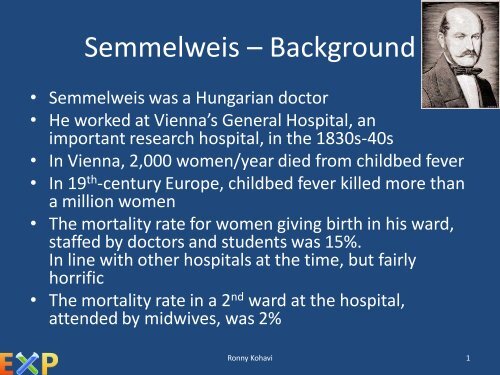Semmelweis Reflex (PDF) - Exp Platform
Semmelweis Reflex (PDF) - Exp Platform
Semmelweis Reflex (PDF) - Exp Platform
Create successful ePaper yourself
Turn your PDF publications into a flip-book with our unique Google optimized e-Paper software.
<strong>Semmelweis</strong> – Background<br />
• <strong>Semmelweis</strong> was a Hungarian doctor<br />
• He worked at Vienna’s General Hospital, an<br />
important research hospital, in the 1830s-40s<br />
• In Vienna, 2,000 women/year died from childbed fever<br />
• In 19 th -century Europe, childbed fever killed more than<br />
a million women<br />
• The mortality rate for women giving birth in his ward,<br />
staffed by doctors and students was 15%.<br />
In line with other hospitals at the time, but fairly<br />
horrific<br />
• The mortality rate in a 2 nd ward at the hospital,<br />
attended by midwives, was 2%<br />
Ronny Kohavi 1
Controlling All Factors<br />
• <strong>Semmelweis</strong> tried to control for all factors,<br />
including birthing positions, ventilation, diet,<br />
and even the way laundry was done<br />
• Finally, two events happened that yielded a<br />
breakthrough<br />
– He was away for 4 months and death rate fell<br />
significantly when he was away.<br />
He concluded that he is related to the problem!<br />
– His friend died after puncturing his finger with a knife<br />
while performing an postmortem.<br />
His friend’s autopsy revealed symptoms similar to<br />
childbed fever<br />
Ronny Kohavi 2
The Connection<br />
• <strong>Semmelweis</strong> proposed the unthinkable:<br />
the doctors were responsible!<br />
– Vienna General was a teaching and research hospital<br />
– Doctors split their time between research on cadavers and<br />
treatment of live patients<br />
– They performed autopsies each morning on women who<br />
had died the previous day<br />
• Particles from cadavers (called germs today) were<br />
being transmitted to healthy patients<br />
on the hands of the physicians<br />
Ronny Kohavi 3
The Solution<br />
• He experimented with various cleansing agents<br />
• He Instituted a policy requiring physicians to<br />
wash their hands in chlorine and lime<br />
• The death rate fell from 18% to 1% in 1848<br />
Ronny Kohavi 4
Disbelief by Medical Community<br />
• <strong>Semmelweis</strong> was dropped from his post at the clinic<br />
• He went to a hospital in Hungary, and reduced<br />
mortality rate in the obstetrics to 0.85%, while in<br />
Prague and Vienna the rate was about 10% to 15%<br />
• His student published a paper about the success of<br />
chlorine washings. The editor wrote<br />
We believe that this chlorine-washing theory has long outlived its<br />
usefulness… It is time we are no longer to be deceived by this theory<br />
• In 1865, he suffered a nervous breakdown, and was<br />
beaten at a mental hospital, where he died<br />
Ronny Kohavi 5
<strong>Semmelweis</strong>, the Pioneer<br />
• In 1879, Louis Pasteur showed the<br />
presence of Streptococcus in the blood<br />
of women with child fever<br />
• <strong>Semmelweis</strong>’s results were accepted<br />
over time, especially as more results<br />
proved him correct<br />
• <strong>Semmelweis</strong> is now recognized as a<br />
pioneer of antiseptic policy with stamps<br />
and coins (new 50 Euro in 2008)<br />
commemorating him<br />
Ronny Kohavi 6
<strong>Semmelweis</strong> <strong>Reflex</strong><br />
• <strong>Semmelweis</strong> <strong>Reflex</strong> is a reflex-like rejection of new<br />
knowledge because it contradicts entrenched norms,<br />
beliefs or paradigms<br />
• Is this just bad science in the past?<br />
• A 2005 research article shows that hand-hygiene practices<br />
among healthcare workers remain unacceptably low<br />
• Inadequate hand washing is one of the prime contributors<br />
to the 2 million health-care-associated infections and<br />
90,000 related deaths annually in the United States<br />
• Is your organization suffering from <strong>Semmelweis</strong> reflex?<br />
• Get the data – run controlled experiments, and learn!<br />
Ronny Kohavi 7


